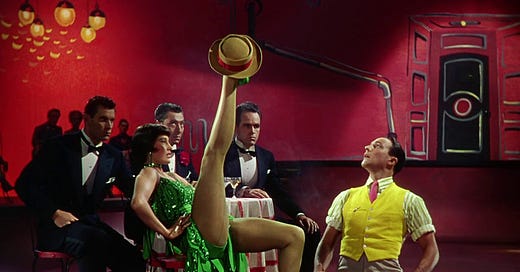August Streaming
We're Cooling Down (Inside) and Leaving the Hard Work to the Professionals: It's Musicals Month, Ma Chère Amie-O!

Welcome to August streaming.
In these dog days of a waning summer, I’ve spent the last two weeks on a steady diet of air conditioning and the Olympics, digging into the physical feats of strength out of a (sizzling) Paris: Peacock’s “Olympics portal” includes a “multi-view” function, meaning at any given moment, I was watching Judo, Water Polo, Swimming, and (maybe) Rugby simultaneously like The Architect, dipping between sports as interest waxed and waned. Always live: for what point is there to the Olympics if not to bear witness? “Why do you gasp like someone died when they fall?” my husband asked during the Men's All-Around Final, after a heartbreaking fall off the accursed pommel horse by Frederick “Flips” Richard, a man I learned about last week. Why do we cry at the birth of a newborn child? The momentous drama; the sheer wretched beauty of the endless human toil! Pick yourself up, brush yourself off, start all over again.
In one particularly unforgettable moment during women’s team gymnastics, after USA gymnast Jordan Chiles nailed her memorable floor routine, the broadcast cut to all the little gymnasts at her home gym in Texas, miming the routine alongside her…wrenching surprising tears from my own eyes. A performer never performs in a vacuum: there’s always someone else watching, waiting, at the top of the stairs or in the wings, ready to follow. Hungry to emulate.
This month’s lineup is preoccupied with the form and feats of the human body: twisting, contorting, tapping, hanging, flipping, posing, freezing… bent into any manner that might entertain and lift us out of our boring, humdrum lives. We’ve got a primer on the “Hollywood Musical,” a trip down Louisiana way, a star that’s the epitome of physical perfection, and a chilly respite from these unpleasant last gasps of summer, which drench me with sweat and paint me a shade you might assume was the result of an allergic reaction (perhaps to life itself). “Do you need a napkin?” people ask, unprompted, when I go outside, instilling total strangers with concern. I’ve been given wipes; fans, both paper and mechanical; even a portable hair dryer by a Real Housewife.1 Even with our greatest minds on the case, I remain a Sentient Scrub Mommy. So I’ll be inside, watching movies. Come join me, won’t you?
The Dance, that's a Dream (of Romance): The Hollywood Musical, a Primer
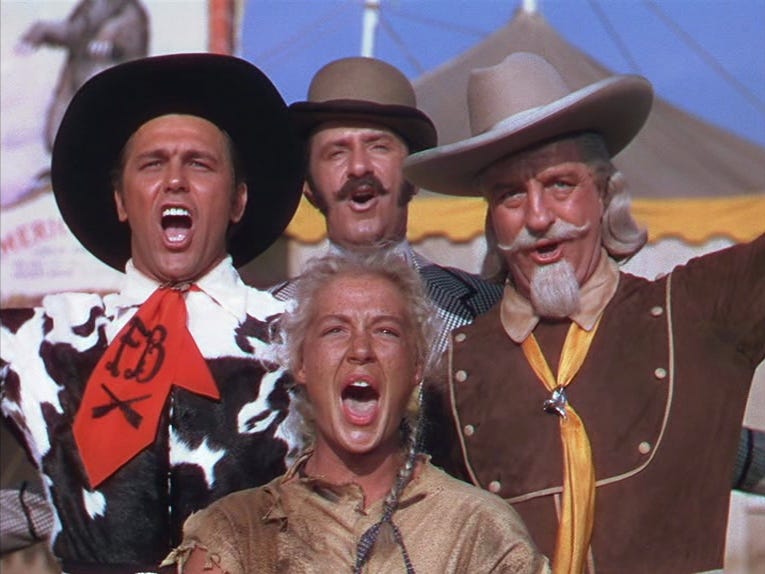
My experiences on the stage were brief, unremarkable, and strangely tethered to the music of the 1943 Rodgers and Hammerstein musical Oklahoma!, which I hate: my sole (and lauded) ensemble performance, in 5th grade, was in Remembering Richard Rodgers, a musical compilation show in which I sang “Many a New Day” with all the commitment and gumption of a Depression-era hoofer. But it was not to be: after that fleeting appearance, I turned to writing about musical theater for the middle school newspaper, which, I suppose, is how we all find ourselves here today. I’ve always loved musical theater, and my love of classic film is resolutely tied to the Hollywood musical: as a child, my neighborhood best friend and I were transfixed by Singin’ in the Rain (1952). There were stretches of time where it felt like we watched it—or Grease (1978)—every day, and in the summer, we’d “play Singin’ in the Rain” in the sprinkler on the front lawn, twirling our umbrellas and screaming Gene Kelly’s signature song like little banshees. The magnum opus of (creep)2 Arthur Freed’s legendary production unit at MGM—whose movie musicals were so prolific, the studio later cashed in on nostalgia with a popular series of anthologies consisting of numbers from their impressive catalog called That’s Entertainment!—Singin’ in the Rain is the most perfect possible musical, both in its unassailable creative elements and the way in which it sidesteps any real concern for narrative coherence, frequently breaking into songs that do little to further the plot but embrace a chaotic, sprawling world of color, melody, and frenetic dance. This is the genre’s ideal form, not an exception to the rule: “Musical entertainment claims for its own all natural and joyous performances in art and in life,” film scholar Richard Dyer wrote in Entertainment and Utopia. “The myth of spontaneity operates to make musical performance, which is actually part of culture, appear to be part of nature.”
Thanks to an established theatrical tradition and wellspring of music and creative talent from the vaudevillian circuit in the early 20th century, The Movie Musical was an early Hollywood invention, dating back to earliest era of synchronized sound,3 with The Broadway Melody of 1929 (1929) winning the second ever Academy Award for Best Picture, making it the first sound film to win the coveted award. Busby Berkeley’s inventive musical extravaganzas of the pre-Code era—like 42nd Street (1933) and Gold Diggers of 1933 (1933)—used the technologies of film to create opulent visuals, differentiating it from the stage and building a filmic language of spectacle and excess. Corny, fun Jeanette MacDonald and Maurice Chevalier musicals from early auteurs like Ernst Lubitsch and Rouben Mamoulian synchronized story with musical performance; Fred Astaire and Ginger Rogers danced across Art Deco sets towards timeless stardom over the course of ten films together; and MGM developed a “house style,” of glitzy, over-the-top musicals, perfected by Freed’s production unit as early as Babes in Arms (1939) and featuring early film innovations like a full-throated embrace of Technicolor processing and experiments with simultaneous live-action / animation. A child star named Judy Garland sang her way to Hollywood history with “Somewhere Over the Rainbow,” and a Broadway performer named Gene Kelly transitioned over to Hollywood, making a name for himself as a dancer and choreographer and begetting a filmography full of creative achievements never to be duplicated.
The Hollywood machine, a vacuum that sucks up every inch of cultural and artistic achievement and regurgitates it in the form of accessible, populist entertainment to the masses, ran on musicals, allowing them to escape the physical limitations of the stage to reach audiences all over the world (other countries, as genre savant Rick Altman once noted, do not have the entrenched movie musical tradition that we do, as other countries do not differentiate film from other art forms as starkly as we do). Musicals survived (and thrived during) the Great Depression, World War II, the advent of television, and the creation (and dismantling) of American Excellence at home and abroad. Big, broad musicals shot in startling Technicolor—and later, daunting widescreen formats4—won Oscars, became international hits, and marked cultural shifts; if Jackie Kennedy termed her husband’s lost administration as “Camelot,” after the man’s favorite 1960 stage musical, isn’t it fitting that the 1967 film adaptation represents the last gasp of American Idealism before the disenchanting events of the Vietnam War, inarguably part of the long reach of JFK’s legacy? As the Hollywood studio system fell apart, so did the Hollywood musical, with the stately My Fair Lady (1964)—itself a source of ire over its controversial casting decisions and subsequent dubbing—and The Sound of Music (1965) becoming the last American musicals to win the Academy Award for Best Picture until Chicago (2002). A musical has not won Hollywood’s top award since.
In today’s terms, we might consider the collapse of the Hollywood musical a negative reaction to “cringe”—that intangible quality of cultural disgust towards things deemed corny, cheesy, irredeemably earnest, or seemingly at odds with the real-life, cutthroat experiences of the American public, forever altered by the countercultural and social justice movements of the late 20th century. Musicals that survived the cultural deluge, generally speaking, mostly flopped or proved an exception to the popular belief that audiences no longer craved musical films. In turn, the Hollywood musical transformed, favoring darker material and deconstructed approaches to the genre like Cabaret (1972); New York, New York (1977); All That Jazz (1979); Fame (1980); and Pennies from Heaven (1981)—not all of which did well at the box office (or with critics), though they are considered classics of the genre. Experiments with the musical genre in the decades since have been… mixed, with few managing to capture the energy of the mid-century musical (likely attributable to a dearth of mainstream performers that came up through the musical theater scene or other American theatrical traditions).
To be a fan of Hollywood musicals, historically, is to suffer: interminable ballads, outdated singing styles, distracting dubbing, ethnic pantomime, listless and/or absurd storylines, and various other curious creative choices made in the process of transporting stage musicals to the big screen. They’re completely different mediums, which is why film adaptations of popular Broadway shows are so infamously fraught: Kismet (1955), Hello, Dolly! (1969), Man of La Mancha (1972), Annie (1982), Annie (2014), Evita (1996), Phantom of the Opera (2004), Rent (2005), Nine (2009), Rock of Ages (2012), CATS (2019), Wicked (2024)… American film history is littered with musicals that stumbled in their journey to the big screen, with typically dismal box office returns to match. Some shows just don’t translate well; others, in their quest to be cinematic, make baffling creative choices like re-staging numbers in absurd situations, dubbing film stars with the soprano-stylings of prolific “ghost singer” Marni Nixon, or—in the case of South Pacific (1958)—using experimental color filters, a look that is actually sort of cool, in an abstracted way, but doesn’t really add anything significant to the film’s aesthetic vision. The primary problem is that many filmmakers do not understand the pace and sense of scale needed to effectively translate show-stopping musical performance to screen—not everyone can be Baz Luhrmann. Early sound-era musicals seized upon possibilities of film technologies to distinguish the genre from Broadway shows, reveling in the fissure between audience and performer as the latter ascends into surreal, fantastical visions of artistic excess. That striking Busby Berkeley iconography—scores of beautiful, mimetic showgirls in symmetrical formations that made use of the entire frame, creating big, beautiful spectacles to draw audiences in—is still referenced and recycled to this day. The timeless physicality of Gene Kelly and Fred Astaire’s dancing translates across barriers of time to excite and overwhelm us, just as Judy Garland and Paul Robeson’s voices still have the power to reverberate deep down into our soul. These days, I’ve noticed the painful Dear Evan Hansen-ification of the contemporary musical theater scene has bled over into the Hollywood musical, plaguing us with static, flat imagery of people walking and singing—or, in the case of one recent, lauded movie musical—casting big-name stars who can’t even half-stumble through a basic tap routine. That’s sad, isn’t it, considering that this rich genre tradition is still our greatest cultural export?
This program includes 180+ Hollywood musicals, from the earliest days of the synchronized sound era… to the jaw-dropping MGM productions of the mid-twentieth century… to the last gasps of the big budget musical in the 60s and the simultaneous rise of the rock and roll musical… to the deconstructed classics of the New Hollywood era… to Chicago (2002) winning Best Picture at the Oscars… and finally to our current cultural moment, when an upsetting, VFX-laden CATS (2019) horrified the general public and brought about the global pandemic.5 I can’t predict the future of the movie musical: currently, it seems Broadway is pulling from Hollywood for ideas, and not the reverse, a reflection—as all things are—of our country’s slavish devotion to capitalism and, in turn, its corrosive effect on the integrity of the performing arts. But what a hell of a ride while it lasted, huh? Let’s go on with the show!
And no La La Land (2016).
Born On the Bayou: Louisiana on Film and Television
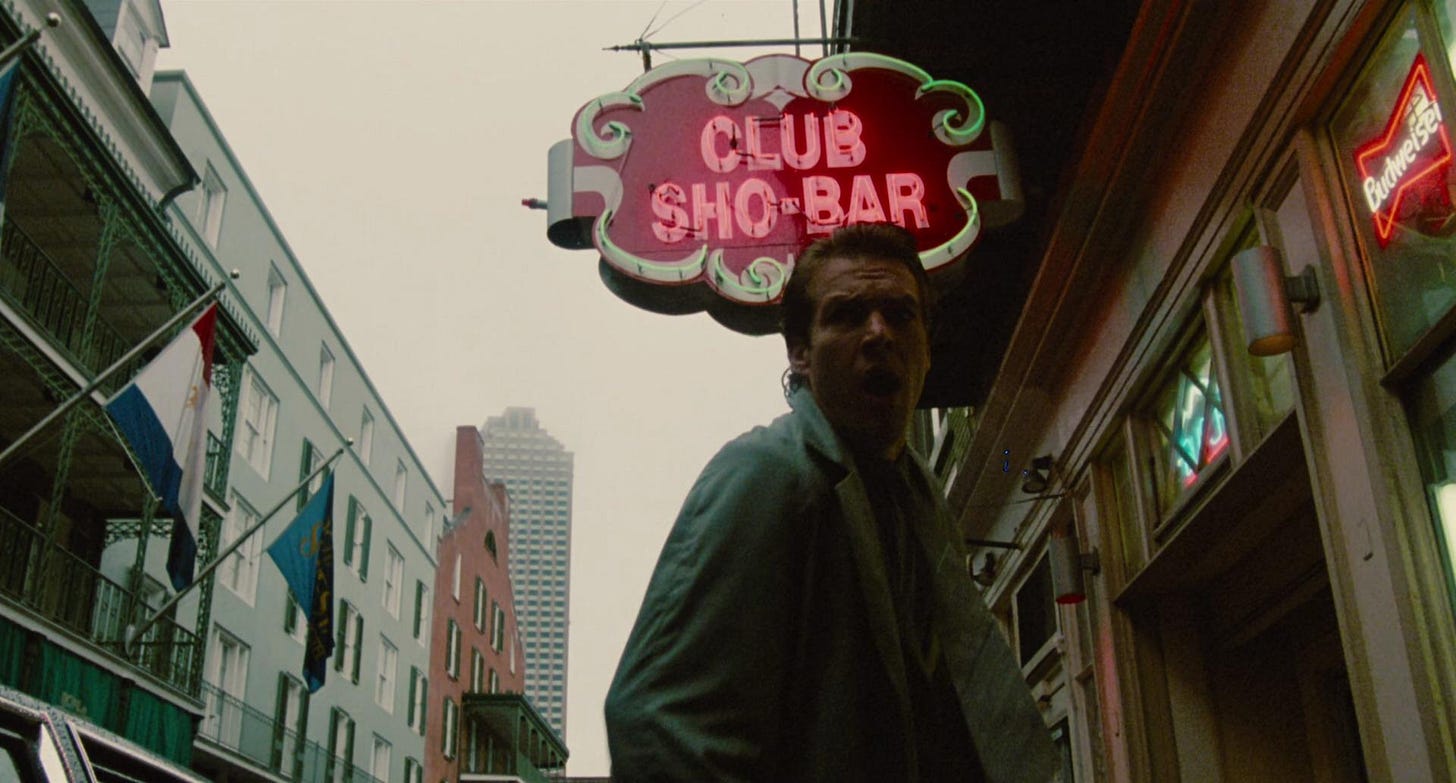
Last year, my husband—a man in his 30s—went on a Bachelor trip to New Orleans, his first visit to the famed Louisiana den of sin, an odyssey that had a transformative effect on his personality. Suddenly, he was talking like John Fogerty—a man born in Berkeley, California—and requesting dishes laden with Tony Chachere’s seasoning, saying things like, “life moves a little differently down on the bayou.” The Mid-Atlantic man longs for a real culture, such as can be found down South. But what is it about New Orleans, and Louisiana in general, that’s so seductive to both the domestic traveler and the cinematic storyteller? The music—obviously; the food—duh; the drinking culture—definitely; but especially the feeling that life is one big party, even in death. In a space where the veil between living and dead feels so very thin—both in the phantasmic allure of local ghost stories, and the real-world tragedies that permanently shaped the region—New Orleans is the best fodder for film and television works navigating the very notion of life and death and all of the base human emotions and impulses that art aspires to understand and articulate. It’s a place of evocative sights, sounds, and smells, lifting off the screen to entice us with seductive visions of Southern bacchanalia and abandon.
Creole baby, Cajun queens, quaint porches and windows, filet de gumbo, the Basin beans, your beautiful Delta and bayous in greens…
Works set in Louisiana outside the city comforts of New Orleans tend to fetishize it as a backwards swamp where any manner of uncivilized behavior—and sinister evil—can occur outside the purview of the law, such as the Apocalypse Now-like thriller / Vietnam allegory that unfurls in Southern Comfort (1981), or the secret, Satanist pedophile rings of True Detective: Season One (2014). In Lucio Fulci’s cult horror film The Beyond (1981), the portal to hell itself is located in rural Louisiana. Oh, Louisiana indeed.
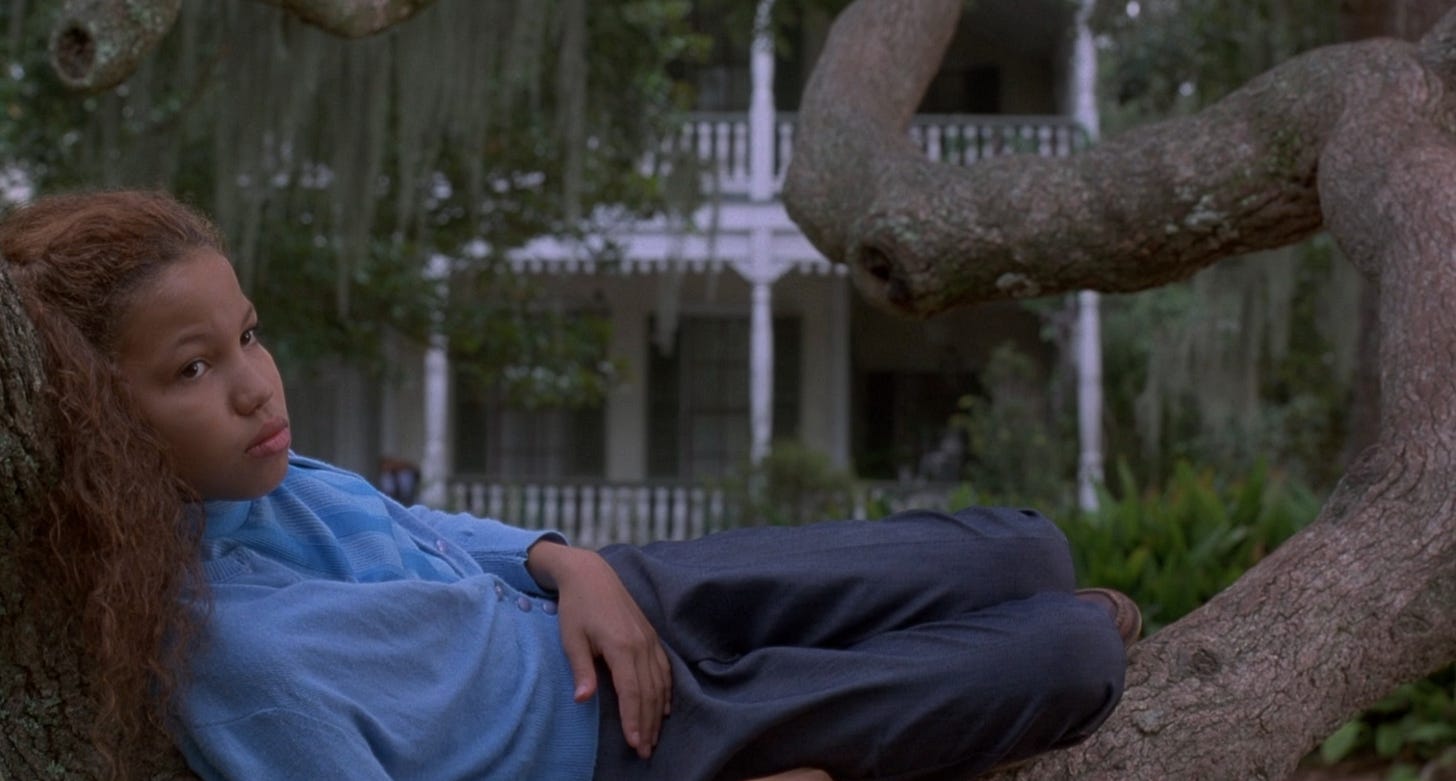
Yet too-few works attempt to interrogate the real-life evil that set root in the region— soaking its very soil with an unquantifiable amount of bloodshed—wrought over a hundred years of human suffering on the region’s plantations, which largely yielded sugarcane and cotton and made its slave owners some of the richest in the nation. The state’s “Antebellum” history is whitewashed in William Wyler’s Jezebel (1938), in which Massachusetts-born Bette Davis plays the fabled headstrong (but benevolent) mistress of a New Orleans plantation, a part allegedly offered in consolation for losing out on the highly coveted role of Scarlett O’Hara in Gone with the Wind (1939). This kind of obsession with Southern white femininity dominates Hollywood movies about life in Louisiana: films included in this program like Saratoga Trunk (1945); A Streetcar Named Desire (1951); Hush… Hush, Sweet Charlotte (1965); Sister, Sister (1987); Steel Magnolias (1989); sex, lies, and videotape (1989); The Man in the Moon (1991); and Divine Secrets of the Ya-Ya Sisterhood (2002) examine the frailty, guile, and complex interior lives of Southern white women who are often burdened by the rigid gender norms of a regional system of inequality that they participated in—and inarguably benefitted from. Despite the tremendous diversity of the region, which contains the second-largest percentage of Black Americans in the country—behind only Mississippi—these films generally offer little insight into the lives of people of color living there. In deliberate contrast, I’ve included works like Sounder (1972), about a family of rural Louisiana sharecroppers led by the late, great Cicely Tyson; Eve's Bayou (1997), Kasi Lemmons’ criminally underrated feature set in an affluent Creole-American region of mid-century Louisiana; Passion Fish (1992), John Sayles’ answer to Driving Miss Daisy; Girl’s Trip (2017), Malcom D. Lee’s deeply irreverent vacation comedy set at Essence Fest; and the recent television adaptation of Interview with a Vampire (2022-present)—a considerable improvement over the straight-washed 1994 film of the same name, also included here—which extirpates the plantation narrative of Anne Rice’s original novel and re-situates the story around a gay man of color, deliberately engaging with the sociopolitics of the region in this process of transposition.
The plantation system and the debilitating economic impact of the Civil War; the exploitative sharecropping system; Jim Crow and the violent backlash to the Civil Rights movement6; utter destruction wrought by Hurricane Katrina, which killed 1,390 people and submerged 80 percent of New Orleans after its levees failed… All of these moments paint a narrative of tragedy that the region itself has continuously overcome despite the total indifference and consistent negligence of government organizations. Yet the region’s irrepressible cultural impact is widespread, like its diverse, multi-faceted music scene (represented in several documentaries included in this program), from jazz to the blues to rock and roll to zydeco to Cajun music to swamp pop to bounce... the sheer breadth and depth of the creative forces working within the region—a wellspring of artistic expression—are a stark counter-narrative to one of doom and gloom. “All over the country / people want to know / whatever happened to Fat Domino / I’m still alive and kickin’,” New Orleans-born and based rock and roll progenitor Fats Domino sang on the opening track to his 2006 album of the same name, released after reports that claimed he had been killed during Hurricane Katrina (he and his family were air-lifted out by the Coast Guard, but they lost all of their possessions in the flood). “I’m still alive and kickin’ and I’m sorry for them that didn’t make it, but we’re gonna make it,” he told NPR at the time (he passed in 2017). “We’re making it.”
This program looks back at the notable films and television shows set down on the Louisiana bayou, from the sweet to the scalding.
“Promiscuous, albeit in a rather cool and glamorous manner”: Marlene Dietrich, International Sex Symbol
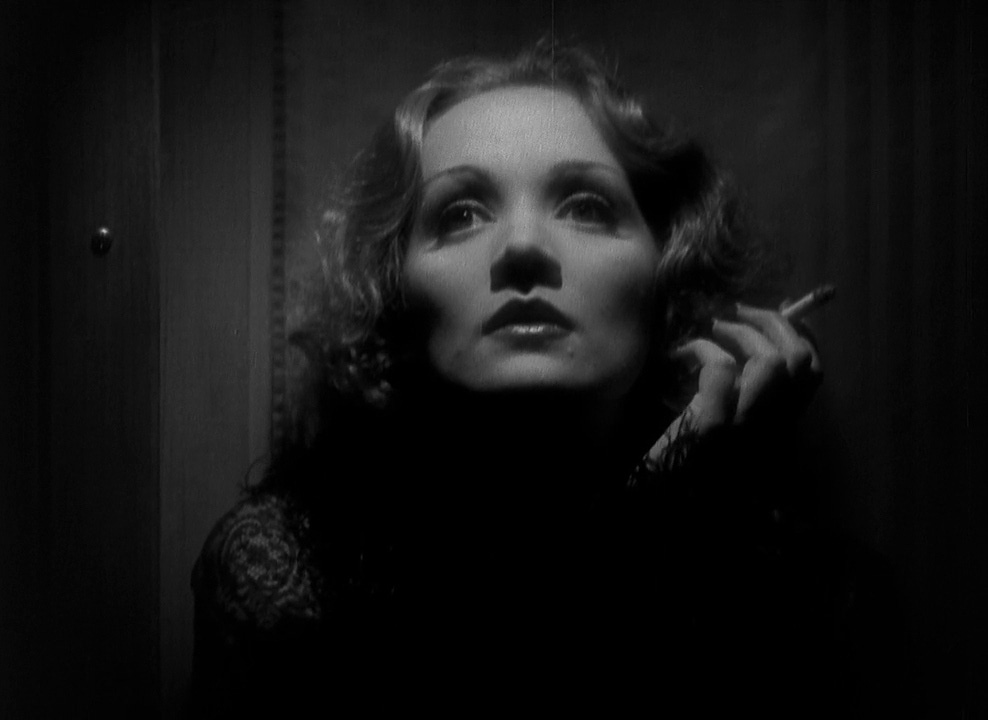
Alluring; severe; intelligent; strong; deliciously, alternatively masculine-presenting and high femme; and strikingly beautiful on-screen, there is no one in Hollywood history—save maybe Charlie Chaplin—more internationally (and universally) beloved than emigré-turned-Hollywood Star Marlene Dietrich, one of the greatest leading ladies of the Classic Hollywood era. A once-struggling German actress discovered and brought back to America by her Svengali, Josef von Sternberg, Dietrich crash landed in Hollywood like an exotic, beguiling asteroid after her star-making performance in Morocco (1930),7 her first film stateside. At the time of their arrival, Sternberg and his young protégé had previously made one acclaimed film for German film studio UFA: Blue Angel (1930), simultaneously shot in German and English, in which Dietrich plays an unrepentant dance hall girl who seduces and discards men, leading them to their ruin. But before that film could even be released in the United States, the actress—off of word-of-mouth alone—was signed by Paramount to try and mimic the success of Swedish actress Greta Garbo at MGM. By the time The Blue Angel was released in the United States, Dietrich was already a star. She cultivated an exotic, aloof persona over the course of her films with von Sternberg, her one-time lover and seven-time director of brooding, artistic melodramas—steeped in international intrigue and lurid, destructive ideas of sex—like Shanghai Express (1932), The Scarlet Empress (1934), and The Devil is a Woman (1935). In these films, mostly terrific, she is the cheapest-looking woman with money and the most sophisticated-looking woman of the gutter. Her carefully controlled screen style—courtesy of legendary Paramount costumer Travis Banton—showcased her famous, lithe legs and made her synonymous with cosmopolitan glamor, handily bearing layers of various textures, beads, feathers, and netting that would dwarf a lesser-star. Her heavily accented-voice, a major source of concern entering the “talkie” era, only added to her allure as a mysterious, sultry sexpot. She received criticism later in her career for her fastidious control of her personal image, particularly her hair, but she keenly studied aspects of film that shaped her on-screen image and knew the exact specifications needed to maintain her status as a sex symbol, which she did, even as she transitioned from film work to cabaret shows later in life. Shirley MacLaine, who met the actress on the set of Around the World in 80 Days (1956), recalled the master class she received from the legendary starlet in her 2012 memoir I’m Over All That:
She was the master of lighting, as well as the master of costume fittings. I used to sit and watch her being fitted in everything from leather tuxedos to full-length sequined gowns… She would ponder deeply over exactly how close the sequins should be sewn together. She loved to design the sequins so the audience could just see through them, revealing the shape of her legs… She also showed me how to string a small, nearly invisible chain [of pearls] under my chin which was then attached to pin curls on either side of my face. This was the Dietrich face-lift.
The stylish, slightly severe art films she made with von Sternberg eventually fell out of fashion, and her pictures began to lose money; in 1938, a now-infamous trade ad targeting "overpaid" actors in Hollywood who failed to recoup their costly salaries labeled her "box office poison," a designation that could have ended her career and rendered her a novelty of her era, like Lillian Gish, Kay Francis, or Ruby Keeler. But Dietrich was a survivor: she had survived childhood in an impoverished, war-torn Germany; demoralizing early work in German film and theater; and a risky move to Hollywood… Once again, she endured. She managed to reinvent herself as a more irreverent star, beginning as early as Desire (1936)—for famed producer Ernst Lubitsch—and culminating with a career-revitalizing turn in Destry Rides Again (1939), a hit Western comedy with James Stewart. After the outbreak of World War II, Dietrich, perhaps more than any other mainstream Hollywood star, put all of her efforts towards the war effort, performing in countless USO tours while frequently under bombardment; aiding in Allied propaganda; working at the Hollywood Canteen; and even auctioning most of her belongings to raise money for the troops while on production of Kismet (1944). Dietrich absolutely despised the Nazi Party for its destructive, oppressive grip on her home country and resisted several attempts by the Nazis to lure her back to Germany—she even considered a scheme to seduce and kill Adolf Hitler (sadly abandoned). Her recording of the German love song "Lili Marleen," a popular wartime ditty for both sides of the Allied / Axis spectrum, may as well have been the swan song of World War II—a minor comfort against the bleak backdrop of violence and carnage—and Dietrich performed it for Allied troops on every one of her tour stops.8 After the war, she reinvented herself yet again, delivering some of her greatest screen performances in classics like Witness for the Prosecution (1957) and Judgement at Nuremberg (1961), in which her characters are painted in fascinating shades of gray, steeped in compassion (and scorn) and capturing the ambiguity of life after wartime. Though Dietrich never won a competitive Oscar (and was only nominated once, for Morocco), her impact on international film and popular culture cannot be overstated: her seductive—yet playful—cabaret style has been copied and parodied by everyone from cabaret acts to comediennes to drag queens, manifesting in works as diverse as international art films and gay pornography.9 Her offscreen infamy and sexual ambiguity—including a revolving door of famous lovers (of both genders) and a personal style at odds with gendered norms of the era—all breathlessly recounted in Hollywood tabloids—only fueled the enigmatic cult of her stardom. Who knows if even half of the outrageous stories purportedly about Dietrich and her outrageous, incredible life are even true; in Hollywood, as the man says, when the legend becomes fact, print the legend.
“Marlene Dietrich is no ordinary woman,” von Sternberg later wrote of his former protégé in his delightfully bitchy 1966 memoir Fun in a Chinese Laundry. “… Never before had I met so beautiful a woman who had been so thoroughly discounted and undervalued. Some of the admirers she subsequently collected came to me to state bitterly that they had sought in vain the image of her that flashed on the screen… I gave her nothing that she did not already have. What I did was to dramatize her attributes and make them visible for all to see; though, as there were perhaps too many, I concealed some.”
Like a Picture Print by Currier and Ives: Frosty Movies
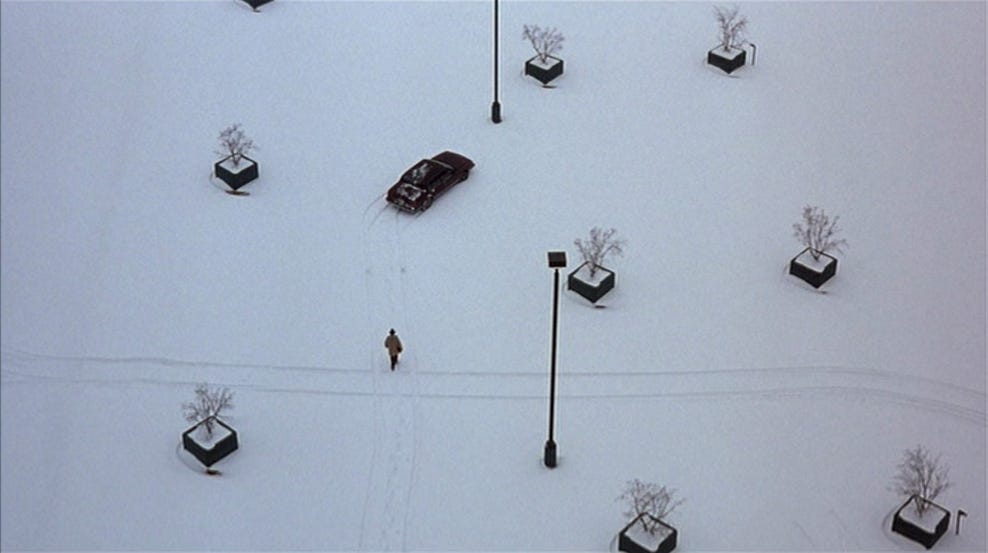
If you’re like me, you find the long, relentless onslaught of summer weather unbearable come August: with temperatures reaching record-breaking triple-digits this summer in the Western United States and the subtropical climate that New York has become, I can’t help but wonder when we are going to begin treating extreme heat with the same severity and weight as extreme cold. As an aforementioned sweat-inclined person, I find the heat totally physically debilitating and personally motivating (…to stay inside and watch more movies). Growing up in 100+ weather in Texas, come August, I was inside, where I’d fashion a literal hovel out of blankets, burrowing inside it with our portable television to turbo-watch VHS tapes in cavernous darkness, sick of the sun. Hot Pocket in hand, I’d escape to faraway, mystical places like São Paulo, Brazil or Reno, Nevada; as an adult, I find myself craving snowscapes and bitter cold, the way we romanticize beach movies in the dead of winter. This program simply collects The Cold: ice skating, winter coats, foggy breaths, and (un)seasonal cheer. Come see the bleak, icy voids of arctic horror stories The Thing (1982) and The Terror (2018); the fabulous furs and ice-covered homes of Bolshevik Russia (seems nice) in Doctor Zhivago (1965); the picture-book winterscapes of All that Heaven Allows (1955), Kwaidan (1965), and The Grand Budapest Hotel (2014); and the French Alps ski chalet we’re told is a depressing tomb, actually, in last year’s Anatomy of a Fall (2023)… These are some of the chilliest-looking films I could find, full of bucolic white visions of snow, beautiful snow. Remember snow?
That’s it for August! We’ll be back next month with more original programming and (far less toe-tappin’). Until then, let’s pick guitar, fill fruit jar and be gay, oh…dress in style and go hog wild, me oh, my oh…
This actually did happen.
In her 1988 autobiography, Child Star, Shirley Temple mentions how Arthur Freed, that titanic figure of the American movie musical, exposed himself to her at age 12, after she had already signed with MGM. This was a studio run by Louis B. Mayer, who allegedly forced a teenage Judy Garland to sit on his lap during meetings, while he groped her. These are far from the only sad stories beneath the frozen images of cheeky innocence found in the mid-century movie musical: Ginger Rogers, at Columbia, was chased around a desk by Harry Cohn; West Side Story’s Rita Moreno was harassed by the head of 20th Century Fox as a teenager, etc.
And obviously, though we think of “silent cinema” as just that, these screenings were accompanied by live music (usually popular songs of the day), establishing a proto-movie musical tradition.
At least one classic musical film was shot to be exhibited in 3-D, George Sidney’s Kiss Me Kate (1953), which is full of amusing winks to the format, including a flying kick at the screen and a tossed hot pink glove launched directly at the audience.
Saw it in theaters four times.
Louisianians' considerable contributions to the Civil Rights movement include a bus boycott in Baton Rouge, the first in the country; sit-ins on Canal Street in New Orleans, and the Bogalusa Civil Rights March, a 105-mile march from Bogalusa to the State Capitol. The Louisiana Civil Rights Trail has a terrific virtual portal tracking these events.
Dietrich’s delicious sexual ambiguity was established from her very first Hollywood film, in which she dons a full men’s tuxedo and top hat and kisses a woman on the lips. “It doesn’t matter if you’re a man or a woman,” she allegedly once said. “I’ll make love with anyone I find attractive.”
For her considerable efforts, she was awarded with an investigation by the Federal Bureau of Investigation on suspicion of being a German spy. They concluded, after two years of investigations, that she was "promiscuous, albeit in a rather cool and glamorous manner.”

